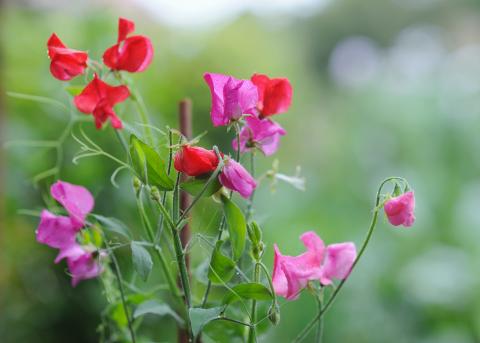Few annual flowers have the lasting appeal and bucolic beauty of sweet peas. Twining lazily around a rustic trellis, they seem the very antithesis of our busy lives. With their seductive fragrance, sweet peas make great flowers for gardens and bouquets. Read our Sweet Pea Growing Guide for information on how to plant and care for sweet peas!
About Sweet Peas
The sweet pea—Lathyrus odoratus—is an annual flower that is at home in a cutting garden, border garden, woodland, or twining on a trellis or an arch. The flowers are now available in a huge range of colors, from pearly white through ice cream pastels to ritzy magentas and inky purples.
Their dainty winged blossoms are matched only by their honey and orange blossom perfume. The combination of the delightful scent and the ability to produce so many blooms for the house over a long period of cutting has ensured their popularity.
Early sowing is one of the secrets to growing sweet peas! Despite their delicate look, sweet peas are quite hardy. In USDA Hardiness Zone 7 or colder, plant them in very late winter or early spring as soon as the soil is dry enough to work. (Do not wait until last frost to sow!)
The first sweet peas were introduced to Britain in 1699 when a Sicilian monk, Francis Cupani, sent seeds of this highly fragrant annual to Dr. Robert Uvedale, a teacher from Enfield, Middlesex. They became hugely popular in North America, both as garden plants and cut flowers. By the late 1800s, California’s growers (including W. Atlee Burpee) shipped trainloads of sweet peas all over the country and developed many further varieties.
Some folks say that growing sweet peas is akin to making a pie crust. Some people have the knack, others don’t. This plant grows from large, easy-to-handle, pea-like seeds. Still, they’re a bit tricky because they are slow to germinate. It’s worth experimenting with different seeds each year.
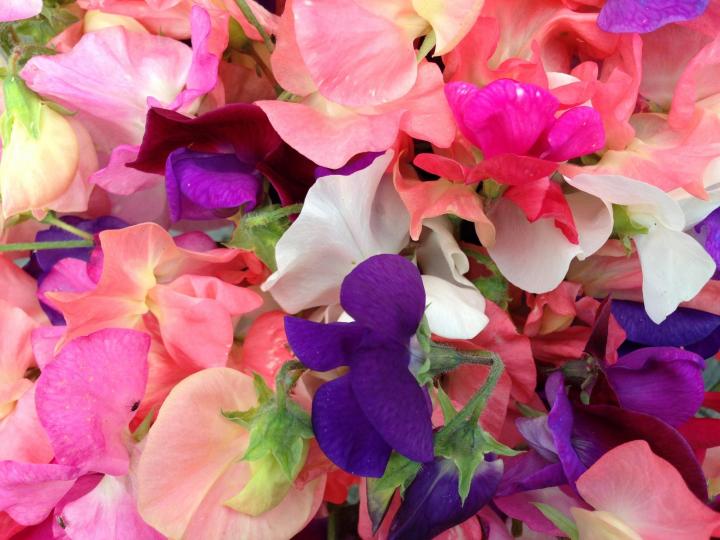
When to Plant Sweet Peas
- In most locations where frosts occur regularly (Zone 7 and colder), sweet peas should be planted in very late winter or early spring as soon as the soil is dry enough to work. (Do not wait until last frost to sow! It will likely be too late.)
- If you garden in mild winter climates (Zones 8, 9, or 10), plant sweet peas in the late fall (November) so they can develop and bloom in late winter and early spring. To get the best display, dig a trench and fill it with well-rotted manure or compost 6 weeks before you sow the seeds. Sweet peas are greedy plants and need a good boost of nutrient rich matter to thrive.
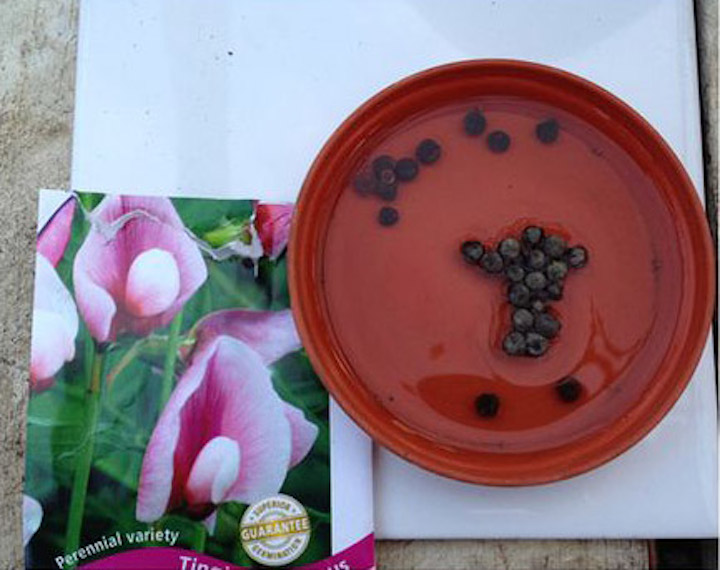 Image: Easy-to-handle sweet pea seeds.
Image: Easy-to-handle sweet pea seeds.
Sowing Sweet Peas Indoors
- In the coldest parts of the country, get a jump on the season by starting sweet peas indoors in a seed tray. Sow in seed-starting containers in early spring about 6 to 7 weeks before the last frost date, then plant out as soon as soil can be worked; sweet peas can handle light frosts.
- Soaking the seeds overnight first softens the outer coating and aids germination. Lightly scoring the outer shell with a nail file can help, too.
- Sow the seeds about half an inch deep in individual cells of a seed tray—2 seeds to a module is fine, but be aware that their long roots have a tendency to tangle and can make separation difficult.
- Once they are showing their first pea-like leaves, gently scoop them out and put them into a larger pot to harden off. The advice I had from one of the most respected sweet pea growers was “to treat the seedlings how I would my husband: stick them in an unheated greenhouse, ignore them, and they will thrive.”
- As soon as the soil can be worked, plant them outside.
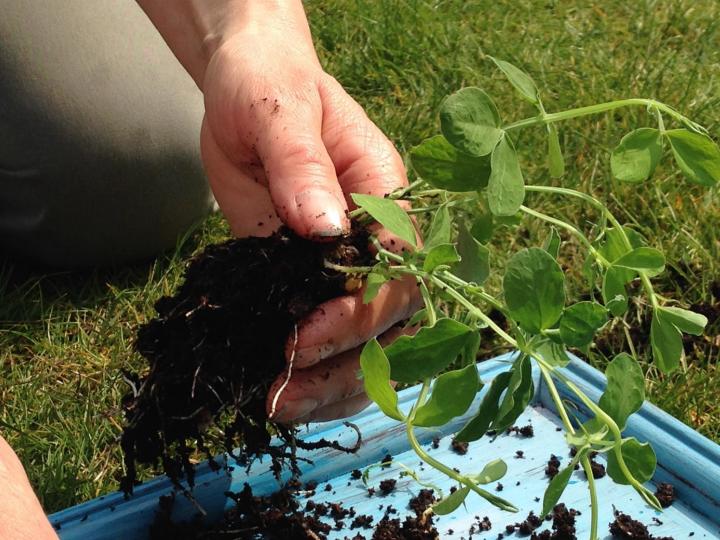
Sowing Seeds in the Ground
- Sweet peas are happiest with their heads in the sun and their roots deep in cool, moist soil. When possible, plant low-growing annuals in front of them to shade their roots.
- Choose a well-drained site. Alkaline soil is best; sprinkle some powdered lime on the surface if your soil tends to be acidic.
- Prepare a rich soil by mixing in generous amounts of compost or well-rotted manure to a depth of 2 feet. (Learn more about soil amendments and preparing soil for planting.)
- Prior to planting, you’re going to want to dig a nice deep “compost” trench of about 4 inches in depth.
- After you dig the trench, make holes with a pencil, drop in the seeds, and press down on the soil to firm it and shut out any light.
- Before planting, soak the seeds in water for 24 hours. Then nick the seeds with a nail file before planting to speed sprouting. You do not need to soak seeds in a temperate climate.
Video: We’ll show you how to plant sweet peas in this video demonstration.
How to Grow Sweet Peas
- Once planted, germination can take 7 to 15 days, depending on the soil temperature.
- As seedlings emerge and grow, gradually fill in the trench. Hoe more soil up to them.
- Keep soil moist. Summer rain may be ample. If you put your finger into the soil bed to its first joint and the soil is dry, water them at the soil level and do so in the morning; sweet peas can suffer from bud drop.
- If you use plenty of aged manure and compost when planting, you do not need to fertilize. If you do want to add nourishment, use high potash feeds, as nitrogen feeds encourage too much top growth.
- When plants become established, mulch well to keep the soil cool and moist. If you mulch, you may not need to water your sweet peas unless the soil gets dry.
- To encourage bushy growth, pinch off the tops when plants are 6 inches tall—not before or you’ll encourage premature side-shoot development.
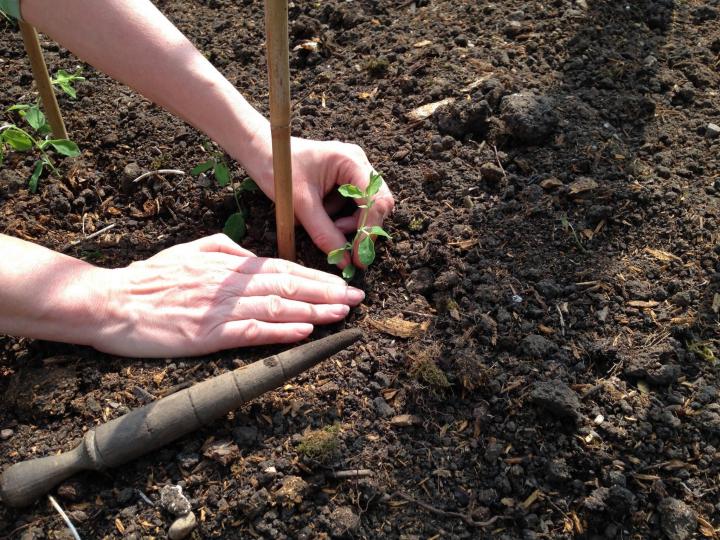
Provide Supports
- Sweet peas prefer cool days and nights and will start to fade when temperatures go above 65°F.
- Except for the bush types, sweet peas are real climbers. Give them at least 6 feet of good support. Some varieties may climb to 9 or 10 feet. Other visually-pleasing supports are bamboo poles in a tee-pee style, a woven willow obelisk, or a trellis. If you don’t have a fence or trellis, provide brush or chicken wire or bushy, stubbly twigs that they can cling to.
- Tie the first few stems in to the support to give the plants a good start and the rest will follow. When they get to 4-8 inches high pinch out the middle growing tip with your thumb and forefinger. This will lead to sturdier plants.
Picking Flowers
- Pick the flowers for bouquets often and the plant will put energy into more blooms instead of going to seed. The more you pick the more they produce, right until the first frosts.
- When the leaves start to lose their color let a few of the last flowers form seedpods. Dry them on a windowsill and then store in an envelope in a dry place to sow next year.
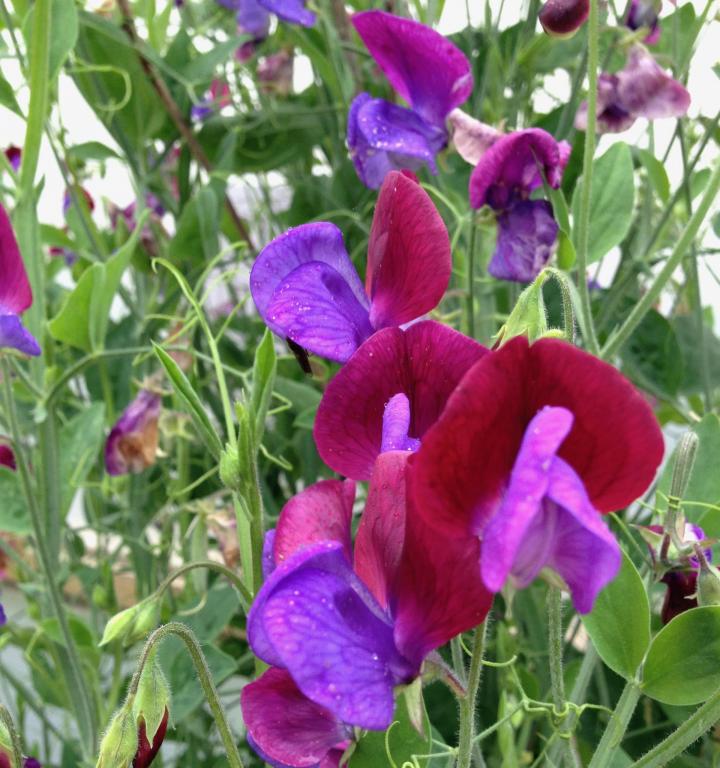
- Slugs and snails may attack young growth.
- Fungal diseases such as Pythium root rot, powdery mildew, rust, gray mold, and various leaf spots are common.
There are sweet pea varieties for every situation, from 8-foot-plus scramblers to dwarf bedding ones suitable for containers and borders without support.
-
In their native Sicily, these ornamental peas have weak stems and an intense orange-jasmine-honey scent. Modern hybrids are stronger-stalked and have larger blooms.
-
At the same time, some of these modern varieties with larger flowers and contemporary hues lack the fragrance of the earlier sweet peas. Sweet pea ‘Cupani’, with it’s bi-colored flowers, maroon upper petals with violet “wings,” is still deservedly popular and is easy to grow.
-
The deliciously-scented ‘America’ is an heirloom, dating to 1896. Its petals unfurl to show stunning wavy red and white stripes.
-
Look for heirlooms like the ‘Old Spice’ collection from Sicily. This strain blooms in shades of white, cream, pink, lavender, and purple.
-
‘April in Paris’ is a fragrant modern variety with large creamy-yellow blossoms and lilac shading.
-
While the common sweet pea is an annual, there is also a perennial unscented broad-leaved everlasting pea, Lathyrus latiflolius. These are clambering plants, which can reach up to 6 or 7 feet and are hardy to zone 5; they are low maintenance plants that flower regularly year on year.
- The sweet pea is an essential member of a late-Victorian garden. Victorians loved sweet peas for their color diversity and fragrance.
- Gather the flowers in the morning when the dew is still on them. This is when their scent is the sweetest.
- Sweet peas are one of the April birth flowers.
“The odor of the sweet pea is so offensive to flies that it will drive them out of a sick-room, though not in the slightest degree disagreeable to the patient.”
–A tip from The 1899 Old Farmer’s Almanac
Here are sweet peas, on tip-toe for a flight:
With wings of gentle flush o’er delicate white,
And taper fingers catching at all things,
To bind them all about with tiny rings.
–John Keats (1795–1821), excerpt from “I Stood Tip-Toe Upon a Little Hill”

